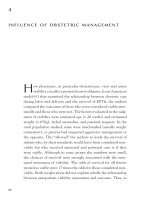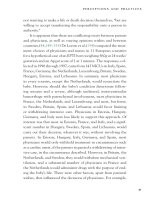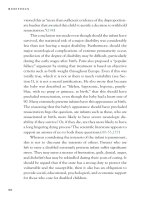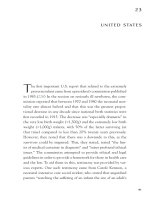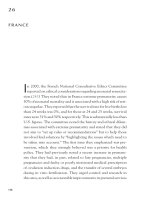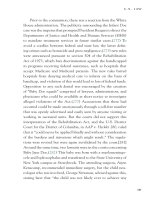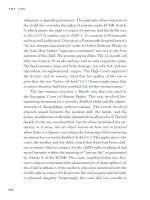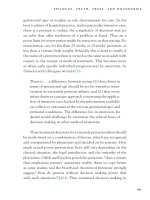Dessler HRM 12e ch 02 equal opportunity and the law
Bạn đang xem bản rút gọn của tài liệu. Xem và tải ngay bản đầy đủ của tài liệu tại đây (1.02 MB, 49 trang )
Chapter 2
Equal Opportunity
and the Law
Part One | Introduction
Copyright © 2011 Pearson Education, Inc.
publishing as Prentice Hall
PowerPoint Presentation by Charlie Cook
The University of West Alabama
WHERE WE ARE NOW…
Copyright © 2011 Pearson Education, Inc. publishing as Prentice Hall
2–2
LEARNING OUTCOMES
1. Explain the importance of and list the basic features of Title VII of
the 1964 Civil Rights Act and at least five other equal employment
laws.
2. Explain how to avoid and deal with accusations of sexual
harassment at work.
3. Define adverse impact and explain how it is proved.
4. Explain and illustrate two defenses you can use in the event of
discriminatory practice allegations.
5. Cite specific discriminatory personnel management practices in
recruitment, selection, promotion, transfer, layoffs, and benefits.
6. List the steps in the EEOC enforcement process.
7. Discuss why diversity management is important and how to
institutionalize a diversity management program.
Copyright © 2011 Pearson Education, Inc. publishing as Prentice Hall
2–3
Equal Employment Opportunity 1964–1991
Title VII of the 1964
Civil Rights Act
(EEOC)
Executive Orders
11246, 11375
OFCCP
Federal Agency
Guidelines
Pregnancy
Discrimination Act
of 1978
Equal
Employment
Opportunity
Vocational
Rehabilitation Act
of 1973
Copyright © 2011 Pearson Education, Inc. publishing as Prentice Hall
Equal Pay Act
of 1963
Age Discrimination
in Employment Act
of 1967
2–4
Title VII of the 1964 Civil Rights Act
• Employer cannot discriminate based on race, color,
religion, sex, or national origin.
Applies to public and private employers with 15 or more
employees.
• Unlawful employment practices for an employer:
To fail or refuse to hire or to discharge an individual because of
the individual’s race, color, religion, sex, or national origin.
To limit, segregate, or classify employees or applicants by their
race, color, religion, sex, or national origin such that they would
be deprived employment opportunities or employment status.
• Equal Employment Opportunity Commission
Copyright © 2011 Pearson Education, Inc. publishing as Prentice Hall
2–5
Equal Employment Opportunity
Commission (EEOC)
• Established by Title VII of the 1964 Civil Rights Act.
• Comprised of five members appointed by the President
for five-year terms; approved by the Senate.
• Administers and enforces civil rights employment law.
• Issues federal guidelines for EEO procedures to be
followed by employers.
• Receives and investigates job discrimination complaints.
Copyright © 2011 Pearson Education, Inc. publishing as Prentice Hall
2–6
Early Court Decisions Regarding
Equal Employment Opportunity
Griggs v. Duke Power Company
1
Burden of job-related proof on employer.
2
Employer’s nondiscriminatory intent is irrelevant.
3
“Fair in form” practice must also be nondiscriminatory.
4
Business necessity is a defense for adverse impact.
5
Test or practice must be related to job performance.
Copyright © 2011 Pearson Education, Inc. publishing as Prentice Hall
2–7
Early Court Decisions Regarding
Equal Employment Opportunity (cont’d)
• Albemarle Paper Company v. Moody
If a test is used to screen candidates, then the job’s specific
duties and responsibilities must be analyzed and documented.
The performance standards for the job should be clear and
unambiguous.
Federal (EEOC) Guidelines on validation are to be used for
validating employment practices.
Copyright © 2011 Pearson Education, Inc. publishing as Prentice Hall
2–8
Equal Employment Opportunity
1990–91–present
Civil Rights Act of 1991
Burden of Proof
Money Damages
Mixed Motives
Disparate treatment
Adverse impact
Compensatory and
punitive awards
Motivation versus
alternative factors
Copyright © 2011 Pearson Education, Inc. publishing as Prentice Hall
2–9
Equal Employment Opportunity
1990–91–present (cont’d)
Americans with Disabilities
Act (ADA) of 1990
Mental
impairments
Qualified
individual
Copyright © 2011 Pearson Education, Inc. publishing as Prentice Hall
Reasonable
accommodation
Employer
defenses
2–10
FIGURE 2–1
Examples of How to Provide Reasonable Accommodation
Copyright © 2011 Pearson Education, Inc. publishing as Prentice Hall
2–11
Employer Obligations Under ADA
• An employer must make a reasonable accommodation for a
qualified disabled individual unless doing so would result in
undue hardship.
• Employers are not required to lower existing performance
standards or stop using tests for a job.
• Employers may ask pre-employment questions about essential
job functions but can not make inquiries about disability.
• Medical exams (or testing) must be job related.
• Employers should review job application forms, interview
procedures, and job descriptions for illegal questions and
statements.
• Employers should have up-to-date job descriptions that identify
the current essential functions of the job.
Copyright © 2011 Pearson Education, Inc. publishing as Prentice Hall
2–12
Employers and ADA
• Employers are not required to tolerate misconduct or
erratic performance, even if the behaviors can be
attributed to the disability.
• Employers do not have to create a new job for the
disabled worker nor reassign that person to a light-duty
position for an indefinite period, unless such a position
exists.
• Employers should not treat employees as if they are
disabled so that they will not be “regarded as” disabled
and protected under the ADA.
Copyright © 2011 Pearson Education, Inc. publishing as Prentice Hall
2–13
The “New” ADA Amendments Act of 2008
(ADAAA)
• ADAA expanded the list of major life activities making it
easier for an employee to show his or her disability as
“limiting” in his or her ability to engage in a major life
activity.
• Under ADAAA, an employee is considered disabled
even if he or she has been able to control his or her
impairments through medical or “learned behavioral”
modifications.
Copyright © 2011 Pearson Education, Inc. publishing as Prentice Hall
2–14
FIGURE 2–2
ADA Guidelines For Managers And Employers
• Do not deny a job to a disabled individual if the person is qualified and able
to perform the essential job functions.
• Make a reasonable accommodation unless doing so would result in undue
hardship.
• You need not lower existing performance standards or stop using tests for
a job. However, those standards or tests must be job related and uniformly
applied to all employees and candidates.
• Know what you can ask applicants. In general, you may not make
preemployment inquiries about a person’s disability before making an offer.
However, you may ask questions about the person’s ability to perform
essential job functions.
• Review job application forms, interview procedures, and job descriptions
for illegal questions and statements about health, disabilities, medical
histories, or previous workers’ compensation claims.
• Itemize essential job functions in job descriptions. In ADA legal actions, a
central question will be what are the essential functions of the job?
• Do not allow misconduct or erratic performance (including absences and
tardiness), even if that behavior is linked to the disability.
Copyright © 2011 Pearson Education, Inc. publishing as Prentice Hall
2–15
Other Employment Acts and Laws
• Genetic Information Nondiscrimination Act of 2008
(GINA)
Prohibits discrimination by health insurers and the use of genetic
information by employers in employment.
Prohibits the intentional acquisition of genetic information about
applicants and employees.
Imposes strict confidentiality requirements.
• State and Local Equal Employment Opportunity Laws
Cannot conflict with federal law but can extend coverage to
additional protected groups.
The EEOC can defer a discrimination charge to state and local
agencies that have comparable jurisdiction.
Copyright © 2011 Pearson Education, Inc. publishing as Prentice Hall
2–16
TABLE 2–1
Summary of Important Equal Employment Opportunity Actions
Action
What It Does
Title VII of 1964 Civil Rights Act,
as amended
Bars discrimination because of race, color, religion, sex, or
national origin; instituted EEOC.
Executive orders
Prohibit employment discrimination by employers with federal
contracts of more than $10,000 (and their subcontractors);
establish office of federal compliance; require affirmative action
programs.
Federal agency guidelines
Indicate guidelines covering discrimination based on sex,
national origin, and religion, as well as employee selection
procedures; for example, require validation of tests.
Supreme Court decisions:
Griggs v. Duke Power Co.,
Albemarle v. Moody
Rule that job requirements must be related to job success; that
discrimination need not be overt to be proved; that the burden of
proof is on the employer to prove the qualification is valid.
Equal Pay Act of 1963
Requires equal pay for men and women for performing similar
work.
Age Discrimination in
Employment Act of 1967
Prohibits discriminating against a person age 40 or over in any
area of employment because of age.
State and local laws
Often cover organizations too small to be covered by federal
laws.
Vocational Rehabilitation Act
of 1973
Requires affirmative action to employ and promote qualified
handicapped persons and prohibits discrimination against
handicapped persons.
Copyright © 2011 Pearson Education, Inc. publishing as Prentice Hall
2–17
TABLE 2–1
Summary of Important Equal Employment Opportunity Actions (cont’d)
Action
What It Does
Pregnancy Discrimination Act of 1978
Prohibits discrimination in employment against pregnant
women, or related conditions.
Vietnam Era Veterans’ Readjustment
Assistance Act of 1974
Requires affirmative action in employment for veterans
of the Vietnam war era.
Ward Cove v. Antonio
Made it more difficult to prove a case of unlawful
discrimination against an employer.
Americans with Disabilities Act of 1990
Strengthens the need for most employers to make
reasonable accommodations for disabled employees at
work; prohibits discrimination.
Civil Rights Act of 1991
Reverses various U.S. Supreme Court decisions; places
burden of proof back on employer and permits
compensatory and punitive money damages for
discrimination.
ADA Amendments Act of 2008
Makes it easier for employee to show that his or her
disability “substantially limits" a major life function.
Genetic Information Nondiscrimination
Act
Signed into law in May 2008, this prohibits
discriminating against employees and applicants based
on their genetic information.
Copyright © 2011 Pearson Education, Inc. publishing as Prentice Hall
2–18
Sexual Harassment
• Sexual Harassment under Title VII
Harassment on the basis of sex that has the purpose or effect
of substantially interfering with a person’s work performance or
creating an intimidating, hostile, or offensive work environment.
Employers have an affirmative duty to maintain workplaces
free of sexual harassment and intimidation.
• Federal Violence Against Women Act of 1994
A person who commits a violent crime motivated by gender is
liable to the party injured.
• When Is the Work Environment “Hostile”?
How frequent and/or severe was the discriminatory conduct?
Was it physically threatening, humiliating, or offensive?
Did it unreasonably interfere with the employee’s work?
Did the employee perceive the environment as hostile?
Copyright © 2011 Pearson Education, Inc. publishing as Prentice Hall
2–19
What Is Sexual Harassment?
•
EEOC guidelines define sexual harassment as:
Unwelcome sexual advances, requests for sexual favors, and
other verbal or physical conduct of a sexual nature that takes
place under any of the following conditions:
1.
Submission to such conduct is made either explicitly or
implicitly a term or condition of an individual’s employment.
2.
Submission to or rejection of such conduct by an individual
is used as the basis for employment decisions affecting
such individual.
3.
Such conduct has the purpose or effect of unreasonably
interfering with an individual’s work performance or creating
an intimidating, hostile, or offensive work environment.
Copyright © 2011 Pearson Education, Inc. publishing as Prentice Hall
2–20
Proving Sexual Harassment
Conditions Proving Sexual
Harassment
Quid Pro Quo
Hostile Environment
Created by
Supervisors
Copyright © 2011 Pearson Education, Inc. publishing as Prentice Hall
Hostile Environment
Created by
Coworkers or
Nonemployees
2–21
Sexual Harassment: Court Decisions
Sexual Harassment Decisions
Meritor Savings Bank,
FSB v. Vinson
Burlington Industries v.
Ellerth
Copyright © 2011 Pearson Education, Inc. publishing as Prentice Hall
Faragher v.
City of Boca Raton
2–22
FIGURE 2–3
HR in Practice: What Employers Should Do to
Minimize Liability in Sexual Harassment Claims
• Take all complaints about harassment seriously.
• Encourage the victim to inform the harasser directly that the conduct is unwelcome and must
stop, and to use any employer complaint mechanism available.
• Issue a strong policy statement condemning such behavior. It should clearly describe the
prohibited conduct, assure protection against retaliation, describe a complaint process that
provides confidentiality, and provide accessible avenues of complaint and prompt, thorough,
impartial investigation and corrective action.
• Inform all employees about the policy and of their rights under the policy.
• Take steps to prevent sexual harassment from occurring. For example, communicate to
employees that the employer will not tolerate sexual harassment, and take immediate action
when someone complains.
• Establish a management response system that includes an immediate reaction and
investigation.
• Train supervisors and managers to increase their awareness of the issues.
• Discipline managers and employees involved in sexual harassment.
• Keep thorough records of complaints, investigations, and actions taken.
• Conduct exit interviews that uncover any complaints and that acknowledge by signature the
reasons for leaving.
• Re-publish the sexual harassment policy periodically.
• Encourage upward communication, for instance, through periodic written attitude surveys.
• Do not retaliate against someone who files a harassment (or other EEO) complaint.
Copyright © 2011 Pearson Education, Inc. publishing as Prentice Hall
2–23
FIGURE 2–4
Online form to facilitate filing report of harassment.
Copyright © 2011 Pearson Education, Inc. publishing as Prentice Hall
2–24
FIGURE 2–4
Online form to facilitate filing report of harassment. (cont’d)
Copyright © 2011 Pearson Education, Inc. publishing as Prentice Hall
2–25

